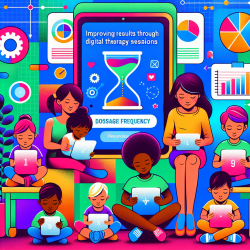Introduction
In the realm of special education and therapeutic services, the integration of technology has opened new avenues for delivering support and interventions. A recent research article titled Stages of Use: Consideration, Initiation, Utilization, and Outcomes of an Internet-Mediated Intervention sheds light on the factors influencing the adoption and efficacy of internet-mediated interventions. This blog aims to inspire practitioners to refine their skills by implementing the findings of this research or to delve deeper into the subject through further study.
Understanding the Stages of Use
The study, conducted by Chiu and Eysenbach, identifies four critical stages in the use of internet-mediated interventions: consideration, initiation, utilization, and outcomes. Each stage plays a vital role in determining the success of the intervention and the benefits it brings to caregivers and their families.
Stage 1: Consideration
In the consideration stage, the perceived ease of use of the intervention is a significant factor. Caregivers are more likely to consider participating if they find the technology user-friendly. This insight emphasizes the importance of designing intuitive interfaces and providing clear, accessible information about the intervention.
Stage 2: Initiation
Once caregivers decide to participate, the initiation stage begins. The study highlights that caregivers with higher technology acceptance tend to start using the service earlier. This finding suggests that practitioners should focus on fostering a positive attitude towards technology among caregivers to facilitate quicker engagement.
Stage 3: Utilization
The utilization stage is crucial as it determines whether caregivers continue using the service or drop out. The study found that caregivers with a positive attitude towards technology and lower perceived competence in caregiving are more likely to continue using the service. Practitioners can enhance engagement by providing ongoing support and resources that boost caregivers' confidence and demonstrate the value of the intervention.
Stage 4: Outcomes
Finally, the outcome stage assesses the impact of the intervention on caregivers' perceived burden. Frequent users of the service experienced a decline in perceived burden, while non-users saw an increase. This finding underscores the importance of regular engagement with the intervention to achieve positive outcomes.
Practical Implications for Practitioners
Practitioners can leverage these insights to improve their delivery of internet-mediated interventions. Here are some practical steps:
- Design User-Friendly Interfaces: Ensure that the technology is easy to navigate and understand, reducing barriers to entry for caregivers.
- Foster Positive Attitudes: Educate caregivers about the benefits of technology and provide training to increase their comfort and acceptance.
- Provide Ongoing Support: Offer continuous support and resources to help caregivers feel competent and confident in using the intervention.
- Encourage Regular Engagement: Highlight the positive outcomes associated with frequent use to motivate caregivers to stay engaged.
Encouragement for Further Research
While this study provides valuable insights, it also opens the door for further research. Practitioners are encouraged to explore additional factors that may influence the adoption and success of internet-mediated interventions. By doing so, they can contribute to the development of more effective and engaging e-health applications.
To read the original research paper, please follow this link: Stages of use: consideration, initiation, utilization, and outcomes of an internet-mediated intervention.










